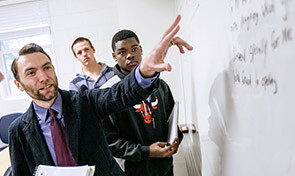Some courses in the adult evening and online programs utilize a team approach to learning. The goal of the learning team is to provide support and a framework for learning to each member of the team. The team should strive to obtain the best results in all challenges and present them in an exemplary manner. To complete team assignments, students may use various approaches of communication as determined appropriate by the course faculty member.
The learning team process has additional advantages over traditional classroom approaches:
- You pool your knowledge and experience with that of other students, which improves comprehension and strengthens your understanding of the material.
- Learning teams simulate the real world. By requiring interpersonal skills, such as teamwork and negotiation, and influencing skills, such as understanding organizational culture and sharing leadership, you develop skills that today's employers require.
- Your decision-making and problem-solving abilities grow stronger. Not only will you gain insights into how teams tackle problems, but learning teams give you the space to try different decision-making approaches.
- Working with other students provides feedback about your own personal characteristics, which increases your self-understanding and your capacity for self-assessment. As a result, you become a better leader-and a better follower.
- The professional and creative quality of course projects is higher because you're combining your knowledge with that of other team members.
- You develop better personal communication skills by observing others' communication methods and by using a variety of interpersonal strategies.
Forming a Learning Team
Students may form their own learning teams, or teammates may be appointed by the faculty member. Keep in mind that successful learning teams typically consist of students from diverse backgrounds. Having students with different experiences strengthens team learning.
If, after a period of time, students decide they are not satisfied with their learning team, it is the responsibility of the student to discuss and initiate a request for change with the course faculty member. Teams generally consist of three to five members.
Developing a Constitution
It may be a good idea for your learning team to write a constitution outlining how the team will operate. This helps ensure fairness and equality within the team.
A fully developed constitution should include the following:
- Participation. Total participation is necessary for the team to achieve its best. Each member should always be prepared to be involved in discussions by completing related assignments and/or readings. When conflict arises, the goal should be to resolve for the betterment of the team.
- Conduct. Learning team members should respect the feelings of each participant. All should be active listeners and encourage one another toward being successful. Each member should remain focused on the subject and use time and speech constructively.
- Fulfill Responsibility to the Team. It is the responsibility of each member to create a learning environment within the team. When participating in learning team activities, team members should be prepared by obtaining the necessary materials to complete assignments and tasks to the standards set by the team.
- Fulfill Responsibility to the Class. To participate in team activities in the classroom, each member needs to be in attendance. Each person should be physically and mentally prepared to learn and present materials. All should share the enthusiasm and support of your group with class members.
Choosing a Meeting Location
In the event face-to-face team meetings are required for on-site evening program students, your learning team will have to choose a designated meeting place. Faculty pre-approval of the meeting location is required.
Approved locations include:
- Institutional classrooms
- Corporate meeting rooms
- Libraries
Locations must have:
- Individual seating for each learning team member
- A desk or flat surface writing area for each student.
- Adequate lighting.
- A quiet area with no ambient noise, such as loud music.
- Adequately controlled temperature to allow for the comfort of each student.
- Internet and phone service to allow students to access the university's library services.
- Adequate restroom facilities.
- Adequate parking.
- Accessibility for all students.
- Ability to facilitate learning objectives of the specific course.


